The global emergency medical equipment market is estimated to be valued at USD 28.37 Bn in 2025 and is expected to reach USD 44.99 Bn by 2032, exhibiting a compound annual growth rate (CAGR) of 6.8% from 2025 to 2032.
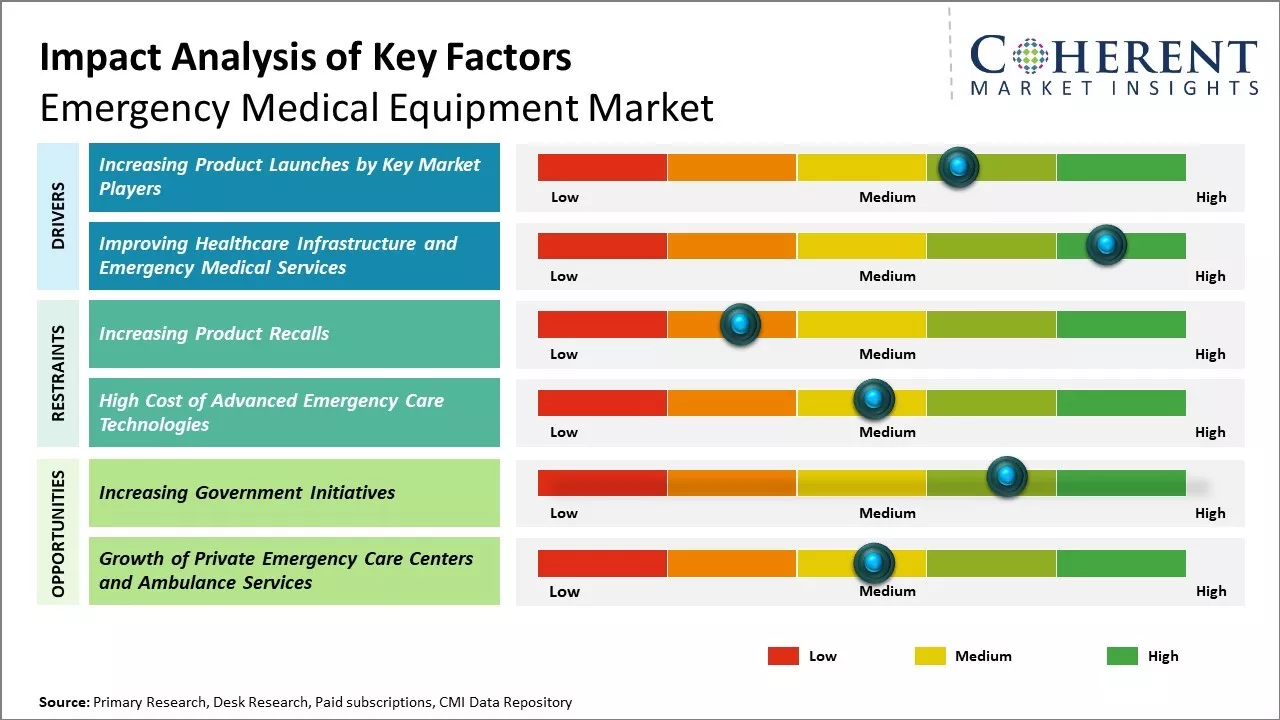
Discover market dynamics shaping the industry: Download Free Sample
The rising incidences of road accidents and trauma injuries, growing aging population, and increasing number of chronic diseases are some of the key factors driving the growth of the emergency medical equipment market. The increasing demand for advanced emergency care and improved emergency facilities worldwide are creating the need for more equipped ambulances and emergency centers. With growing medical infrastructure and availability of insurance coverage for emergencies, the demand for quality emergency equipment is expected to rise substantially in the coming years. However, high costs of emergency care equipment and lack of skilled professionals in some developing nations may restraint the market growth to some extent over the years to come.
Increasing Product Launches by Key Market Players
Market players are involved in launching new drugs, and this is expected to drive the growth of the global emergency medical equipment market over the forecast period. For instance, in March, 2021, HealthTrust Europe, a healthcare company, launched the new safe patient moving and handling equipment framework to support and facilitate the appropriate movement of patients in the hospital, residential, or patient home environments. It is designed to equip health and social care providers with the latest tools to enhance the safety of patient handling.
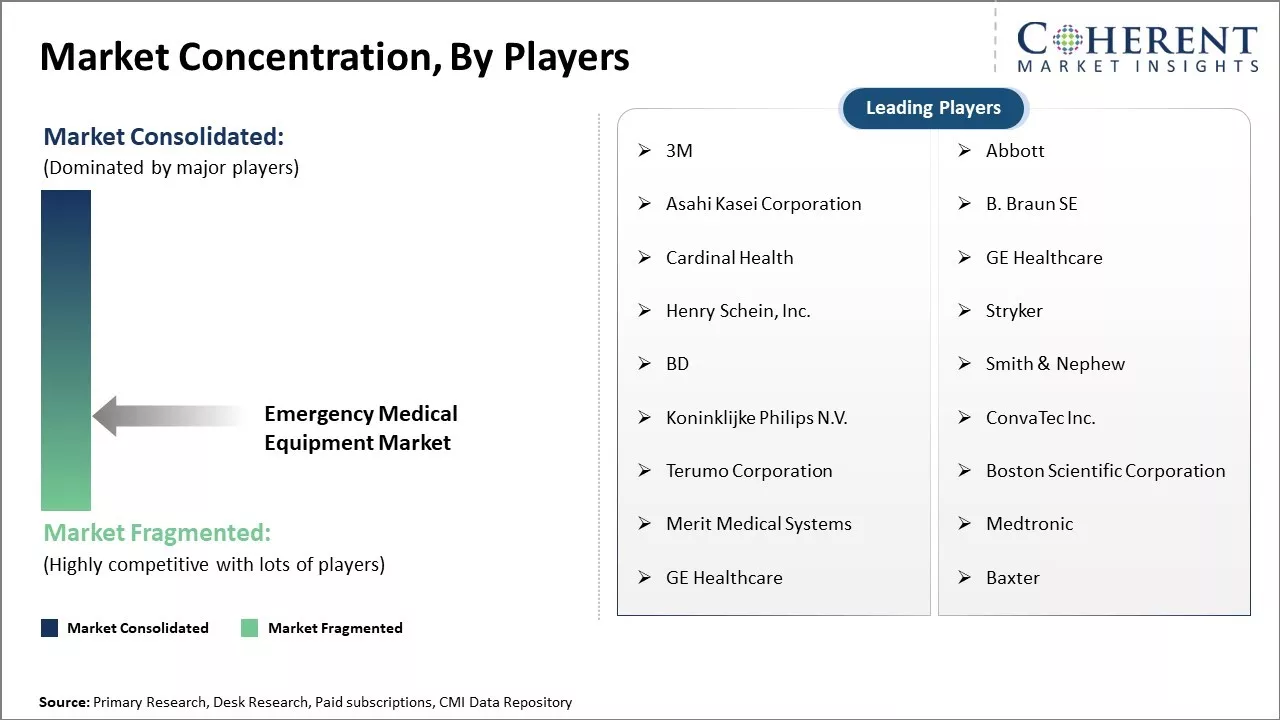
Get actionable strategies to beat competition: Download Free Sample
Improving Healthcare Infrastructure and Emergency Medical ServicesNumerous developing nations across Asia Pacific, Latin America, Middle East, and Africa have shown tremendous efforts in revamping their healthcare infrastructure and emergency medical services over the past decade. Factors such as rising healthcare expenditure, growing public-private investments, and implementation of favorable regulations have accelerated infrastructure development activities in these emerging economies. Availability of well-established emergency care centers, trauma centers as well as upgradation of ambulances are prominent healthcare infrastructure developments undertaken. Governments are also promoting community paramedic programs and pre-hospital emergency services which utilize portable emergency medical equipment. Advanced emergency medical equipment play a pivotal supportive role in the provision of effective pre-hospital and in-hospital emergency care. Life-saving devices like defibrillators, ventilators, and diagnostic imaging systems find extensive usage in emergency departments, ambulances, and critical care units. Their widespread incorporation optimizes emergency response, diagnosis, and clinical management of trauma cases and medical emergencies. Integration of innovative technologies in emergency medical devices also matches with the objectives of modernizing healthcare infrastructure. Continuous procurement of modern equipment ensures delivery of specialized emergency care and treatment.
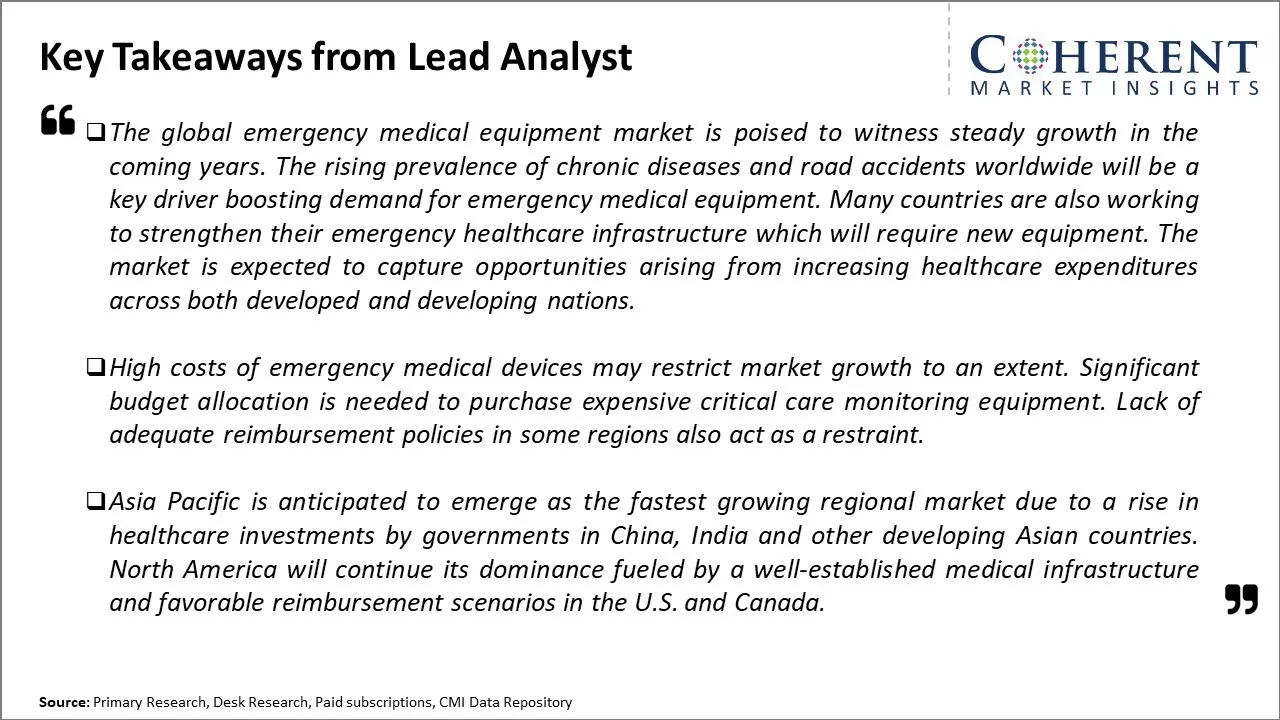
To learn more about this report, Download Free Sample
Market Challenges – Increasing Product RecallsIncreasing number of product recalls by regulatory authorities such as the U.S. Food and Drug Administration are expected to hinder the market growth over the forecast period. For instance, in September 2022, the U.S. Food and Drug Administration recalled a class I BiPAP machine, a type of ventilator, which is manufactured by Koninklijke Philips N.V., a medical device company. The device was recalled because the machines may contain plastic in their motors that release volatile organic compounds which have the risk for users inhaling dangerous volatile organic compounds and the plastic could also cause device failure.
Market Opportunities – Increasing Government Initiatives
Increasing government initiatives is expected to offer lucrative growth opportunities over the forecast period. For instance, in October 2022, the government of India, announced that it had launched the new Helicopter Emergency Medical Services under project ‘Sanjeevani’ and the service will start at AIIMS, Rishikesh, India, that intends to expand medical outreach and access to trauma care services to a wider population across the country using helicopters.
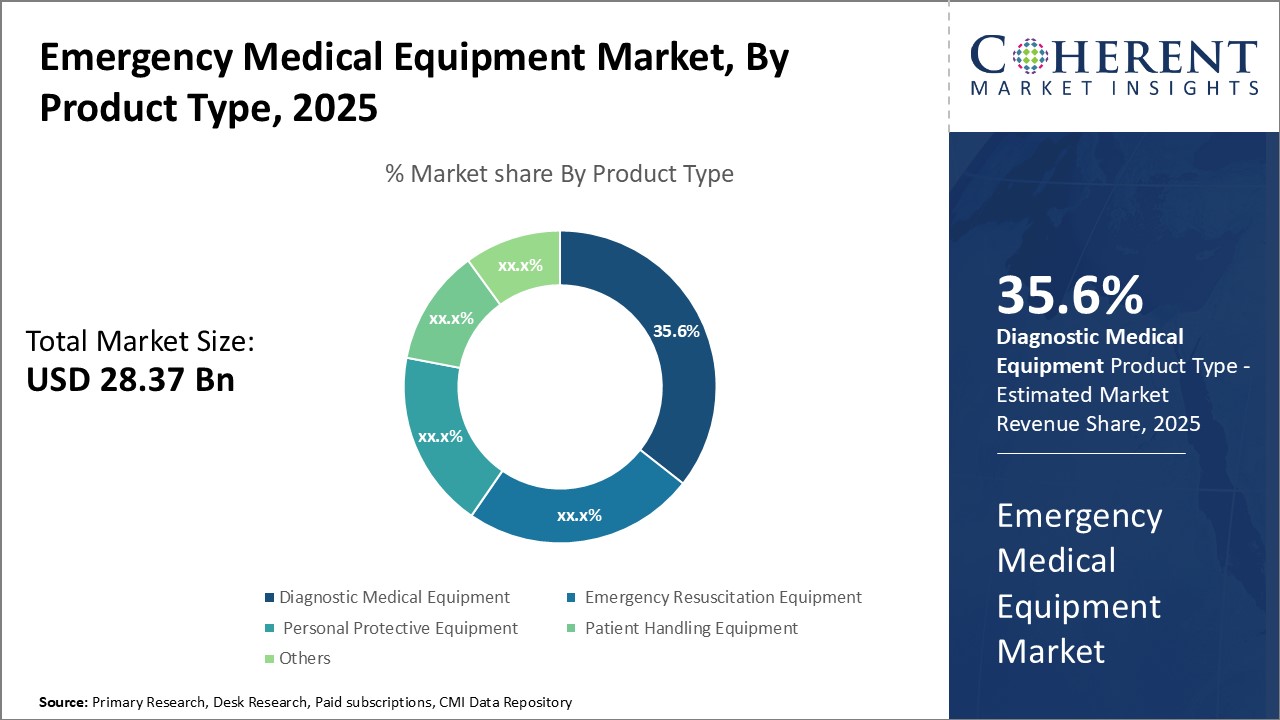
Discover high revenue pocket segments and roadmap to it: Download Free Sample
Insights, By Product Type: Rising Demand for Better Diagnosis Drives the Dominance of Diagnostic Medical EquipmentThe product type segment includes diagnostic medical equipment, emergency resuscitation equipment, personal protective equipment, patient handling equipment, and others. The diagnostic medical equipment sub-segment is estimated to hold 35.6% of the market share in 2025 owing to the rising need for advanced diagnostics across the world. Diagnostic medical equipment includes various devices that help physicians accurately diagnose medical conditions in patients. The increasing prevalence of chronic and lifestyle diseases have boosted the demand for reliable diagnostic tools. Advanced diagnostic technologies allow for early detection of diseases, more accurate diagnoses, and improved clinical outcomes. Furthermore, growing investments by both public and private players into state-of-the-art healthcare systems have enabled wider access to diagnostic facilities. This has significantly enhanced the lifetime management of patients through continuous monitoring. Rising healthcare expenditures coupled with greater health awareness among patients have also driven the uptake of diagnostic tests.
Insights, By Application: Critical Importance of Cancer Care Augments its Dominant Position
The application segment includes cardiac care, cancer care, respiratory care, trauma, and others. The cancer care sub-segment is estimated to hold 34.8% of the market share in 2025 due to the critical importance given to this therapeutic area. Cancer is one of the leading causes of mortality worldwide and its incidence has been increasing rapidly. Early detection and effective treatment of cancer are crucial to enhance survival rates. This has prioritized investments into specialty cancer care equipment and facilities. Growing awareness about cancer symptoms and risk factors has also boosted preventive screenings. Technological advancements are further improving the diagnostics, monitoring, and supportive care associated with cancer. All these factors have firmly established cancer care as a clinical priority, thereby raising its market dominance among application segments.
Insights, By End User: Hospitals Remain the Largest End Users due to Superior Infrastructure and Expertise
The end user segment includes hospitals, ambulatory surgical centers, and others. The hospitals sub-segment is estimated to hold 33.4% of the market share in 2025 owing to their well-established infrastructure and pool of specialized staff. Hospitals are equipped to efficiently handle all types of emergency cases using the latest medical devices and technologies. They have critical care units, trauma centers, and specialty departments to effectively manage complex health conditions. Given their scale and resources, hospitals can easily invest in high-end equipment to provide comprehensive care. There is also a sizable patient footfall in hospitals compared to other medical facilities. The availability of multi-specialty experts under one roof enhances clinical outcomes. These advantages of hospitals have made them the preferred access point, especially for serious illnesses, thereby cementing their top position among end users.
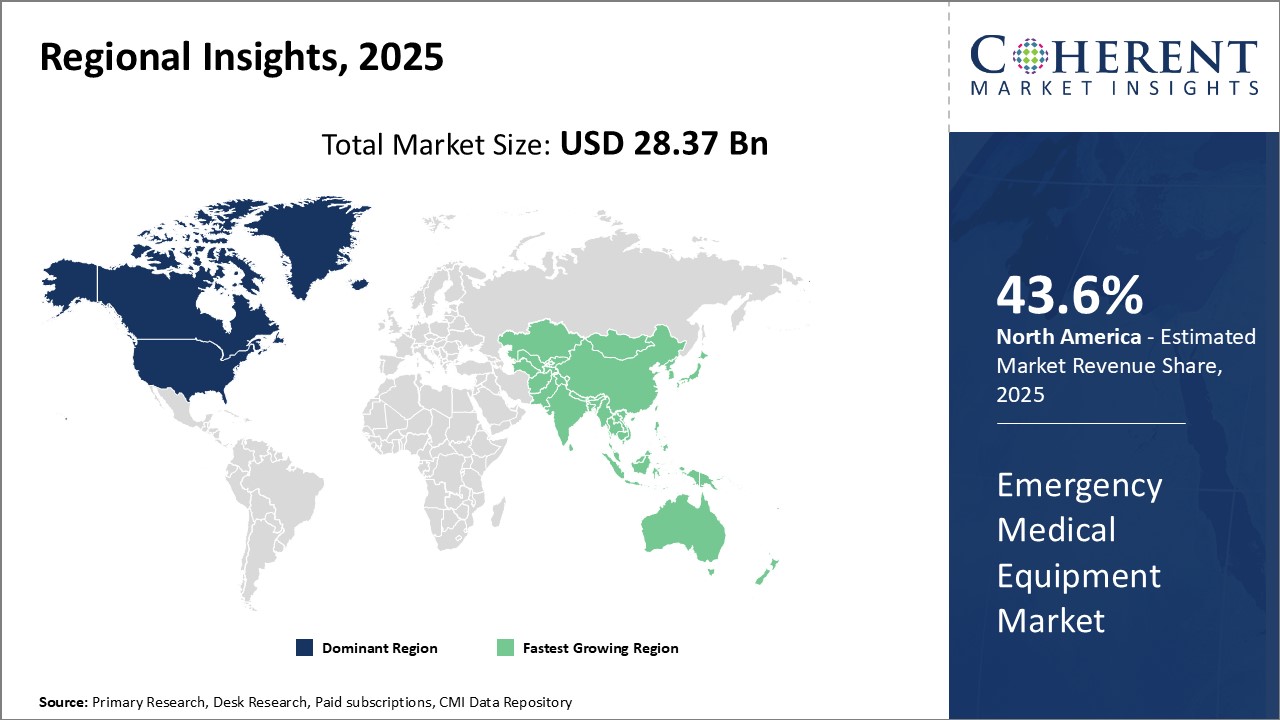
Need a Different Region or Segment? Download Free Sample
North America remains the dominant region in the global medical sensors market and is estimated to hold 43.6% of the market share in 2025 due to strong demand from the well-established healthcare infrastructure and presence of major industry players in the region. The presence of large healthcare providers, private emergency medical services, and firefighting departments has supported the demand for various emergency medical equipment such as defibrillators, ECG devices, wheelchairs, stretchers, and ambulance services. Additionally, factors such as increasing government spending on healthcare and rising awareness about emergency medical services have contributed to the North America region continuing its leadership position. However, the region faces challenges of an aging population and rising healthcare costs which are prompting healthcare reforms.
The Asia Pacific region has emerged as the fastest growing market for emergency medical equipment in recent times riding on improving access to healthcare facilities and rising healthcare expenditures. Countries such as China, India, Indonesia, and Vietnam are witnessing rapid economic development which has boosted investments in modernization and expansion of their healthcare infrastructure including setting up emergency response systems and dedicated ambulance services. This has opened lucrative business opportunities for established multinational emergency medical equipment manufacturers as well as local players. Additionally, Asia Pacific nations have also been increasingly importing premium grade medical devices to fulfill the demand of tier-1 hospitals and trauma centers. The cost competitiveness of the region coupled with rapidly growing middle-class population is further attracting global companies to establish manufacturing bases to cater to domestic as well as international markets. While medical regulations and pricing policies still vary across APAC countries, overall demand conditions have remained very conducive.
Emergency Medical Equipment Market Report Coverage
| Report Coverage | Details | ||
|---|---|---|---|
| Base Year: | 2024 | Market Size in 2025: | USD 28.37 Bn |
| Historical Data for: | 2020 To 2024 | Forecast Period: | 2025 To 2032 |
| Forecast Period 2025 to 2032 CAGR: | 6.8% | 2032 Value Projection: | USD 44.99 Bn |
| Geographies covered: |
|
||
| Segments covered: |
|
||
| Companies covered: |
3M, Abbott, Asahi Kasei Corporation, B. Braun SE, Cardinal Health, GE Healthcare, Henry Schein, Inc., Stryker, BD, Smith & Nephew, Koninklijke Philips N.V., ConvaTec Inc., Terumo Corporation, Boston Scientific Corporation, Merit Medical Systems, Medtronic, GE Healthcare, and Baxter |
||
| Growth Drivers: |
|
||
| Restraints & Challenges: |
|
||
Uncover macros and micros vetted on 75+ parameters: Get instant access to report
*Definition: Emergency medical services, more commonly known as EMS, is a system that responds to emergencies in need of highly skilled pre-hospital clinicians. The World Health Organization (WHO) refers to EMS systems as an integral part of any effective and functional health care system. Emergency medical equipment facilitates patient care during medical emergencies such as accidents and natural calamities, helps prevent loss of life, and minimizes personal injuries. This equipment vary from basic stretchers to complex equipment used in intensive care units and operation theaters.
Share
Share
About Author
Komal Dighe is a Management Consultant with over 8 years of experience in market research and consulting. She excels in managing and delivering high-quality insights and solutions in Health-tech Consulting reports. Her expertise encompasses conducting both primary and secondary research, effectively addressing client requirements, and excelling in market estimation and forecast. Her comprehensive approach ensures that clients receive thorough and accurate analyses, enabling them to make informed decisions and capitalize on market opportunities.
Missing comfort of reading report in your local language? Find your preferred language :
Transform your Strategy with Exclusive Trending Reports :
Frequently Asked Questions
Joining thousands of companies around the world committed to making the Excellent Business Solutions.
View All Our Clients